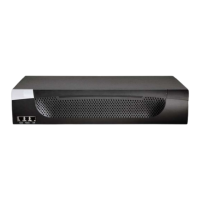USING THE WEB INTERFACE
EATON Managed ePDUt User’s Guide S 164201xxx Rev 1 DRAFT 10−OCT−2008
61
2. For each physical sensor (shown as a row) in the table, select the logical sensor
(shown as columns) you want to map it to. The ePDU will now track this
sensor’s readings and display them on the Home page when configuration is
finished.
If you do not want to track the readings of a particular sensor, leave that row
blank.
3. To unmap a logical sensor from any physical sensor, click clear at the bottom of
the column. That logical sensor will no longer be associated with any of the
physical sensors.
NOTE It is possible (but not advisable) to map more than one logical sensor to a single physical sensor. You
cannot map multiple physical sensors to a single logical one.
Configuring Environmental Sensors and Thresholds
To make sensors more useful, you should rename the logical sensors that are in use
and configure their threshold settings. Configuring thresholds for these sensors
allows the ePDU to generate an alert whenever environmental factors at those
sensors move outside of your ideal values.
1. From the Environmental Sensors page, locate the logical sensors that have been
mapped to physical sensors as described above.
2. In the Name field, type a new name for each mapped sensor that will help you
identify the sensor and its purpose.
Figure 56. Configuring Environmental Sensors
3. Configure the upper and lower thresholds for each sensor in use.
S The Upper Critical and Lower Critical values are points at which the ePDU
considers the operating environment is critical, and outside the range of the
acceptable threshold.
S Once critical, the temperature or humidity must drop below the Upper
Non−Critical (or raise above the Lower Non−Critical) value before the ePDU
considers the environment to be acceptable again.
4. Click Apply to save the settings.

